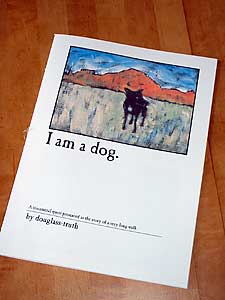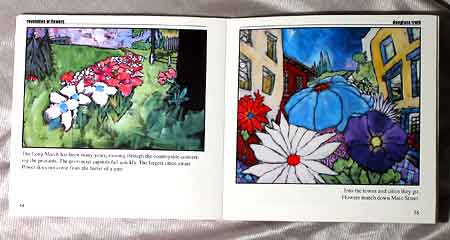
As the name suggests, the book is about a revolution of flowers. Accompanying a series of paintings, Douglass Truth writes short vignettes, such as “Simple flowers. Living among the humans. But they’re watching. They see what we do.”
Flowers are watching us as we work and play. Sounds like a unique idea, so why might you need to suspend belief? Because in the introduction, it says, “This work was transmitted to Douglas Truth one early morning in 2001…After numerous unsuccessful attempts to translate the work into English…Truth gave up on the linguistic route entirely. Distraught and frustrated, he decided to paint the manifesto.”
This might be an elaborate multi-layered art project, but the way the narrative unfolds, you get the sense that the author and painter believes that flowers are actually watching over us. I came to this book with a more esoteric point of view. I’ve read books about channeling before, having started the book a devout skeptic and leaving a curious agnostic. The book asks you to suspend disbelief and let go, and you would not get nearly as much from the book unless you did. So perhaps the book is a lesson in letting go of preconceptions and believing in the unbelievable.
The book was not be nearly as effective, and kind of haunting, if the paintings weren’t well-conceived, and they are:
Douglass Truth is an evocative painter – better in the book than reproduced here – which makes Revolution of Flowers a successful and moving book.

I’m not certain, though, if Truth intends this to be a straight children’s story. It’s possible it’s simply an art project and the intended audience is not really an issue. The book is described on the back as “a mystic’s journey through the landscape of an awakening self.”
Perhaps, but it’s also a story about a dog and a turtle. In my own experience with the book, I read the book with my daughter who implored me to keep reading. As a straight children’s story, it could be pared down a bit, but generally it’s a quietly mysterious story that could introduce a child to themes and artwork with more depth than most children’s stories.
Douglass Truth’s books and artwork are released through Teahouse of Danger: “A group of artists working together to bring you their work, at a cost that almost anyone can afford.”
Get an Editorial Review | Get Amazon Sales & Reviews | Get Edited | Get Beta Readers | Enter the SPR Book Awards | Other Marketing Services























Leave A Comment